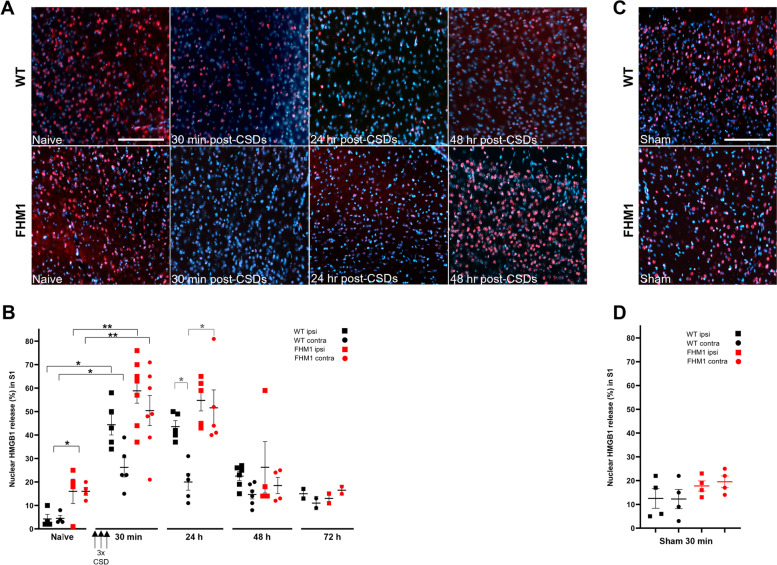Fig. 5.
Optogenetic CSDs trigger a prolonged neuroinflammatory response in the cortex of FHM1 mutant compared to WT mice. A Representative photomicrographs of HMGB1 immunolabeling of the primary somatosensory cortex (ipsilateral to the side of optogenetic CSD induction) of a WT and a FHM1 mutant mouse. HMGB1 immunolabeling is shown as red fluorescence signal. In naïve (untreated) mice, HMGB1 is located in cell nuclei as indicated with co-labeling with Hoechst-33258 (blue). CSD triggers massive release of HMGB1 from neuronal nuclei to the extracellular space 30 min after three optogenetically-induced CSDs (‘3x CSD’) in both WT and FHM1 mutant mice. At 24 h, in the ipsilateral cortex, release was still pronounced in both WT and mutant mice and less so at 48 h in both groups. B Quantification of the % of cells displaying nuclear HMGB1 release showed that release was higher in naïve (untreated) FHM1 mutant compared to WT mice. At 30 min, both ipsi- and contralateral release were increased in both FHM1 mutant and WT mice, with ipsilateral release being higher than contralateral release in WT mice, whereas in FHM1 mutant mice release was equally high in both hemispheres. Of note, contralateral release was higher in FHM1 mutant mice than WT mice at this time point. At 24 h after CSD, HMGB1 release remained elevated compared to baseline in the ipsilateral and contralateral cortex for both WT and FHM1 mutant mice. Compared to WT mice, at 24 h, FHM1 mutant mice showed a more pronounced HMGB1 release in the contralateral cortex. At 48 h following CSD, cortical HMGB1 release in WT mice remained increased compared to baseline levels whereas release had normalized in both hemispheres for FHM1 mutant mice, but note that baseline levels in FHM1 mutant mice are elevated compared to WT. C Representative photomicrographs of HMGB1 immunolabeling of the primary somatosensory cortex (ipsilateral to the side of sham stimulation) of a WT and a FHM1 mutant mouse. D HMGB1 release in the ipsi- and contralateral cortex is not affected by sham stimulation in either genotype. * p < 0.05, ** p < 0.01. Black asterisks and brackets: uncorrected p-values. Grey symbols: corrected p-values (after Kruskall-Wallis; see Results text for number and nature of corrections). Scale bar: 250 μm (applicable to all photomicrographs)

